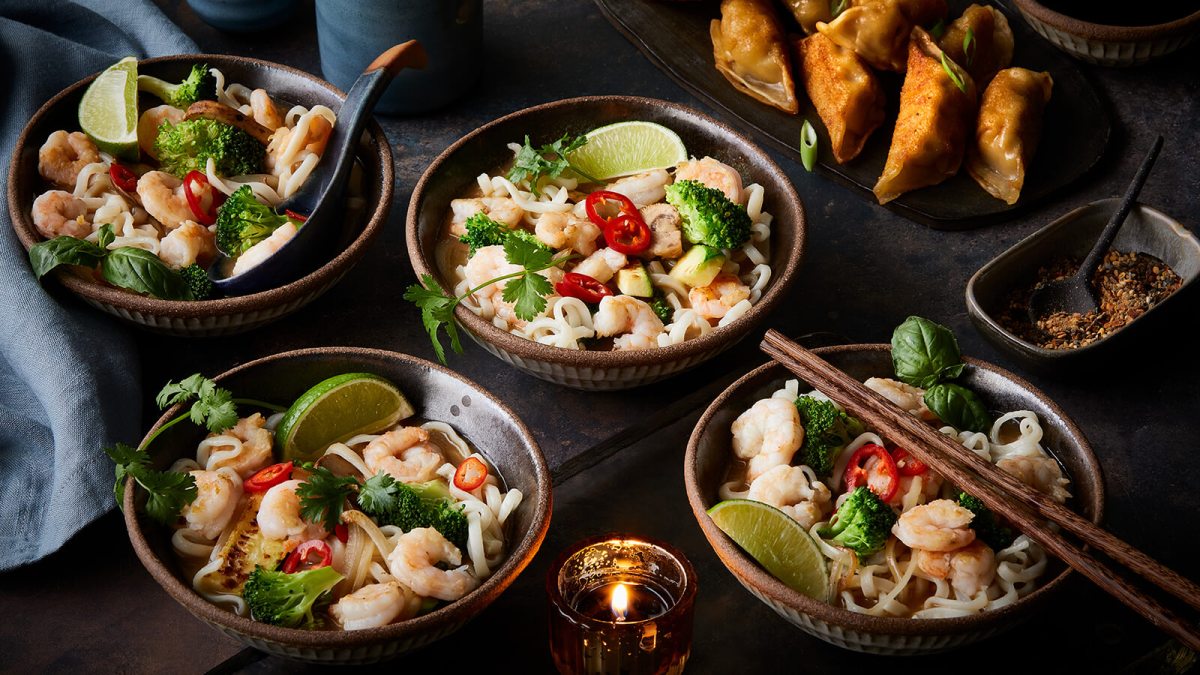Dive into a world of vibrant flavors and textures with this exploration of Asian noodle bowls, eschewing creamy richness for the lighter, brighter appeal of flavorful broths and bold seasonings. We’ll journey through a diverse range of noodle types, from delicate rice vermicelli to hearty buckwheat soba, each perfectly paired with a broth designed to highlight its unique character. Discover the art of layering flavors using soy sauce, fish sauce, rice vinegar, and a symphony of aromatic spices and herbs, creating a depth of taste that’s both satisfying and refreshingly clean.
This guide offers a comprehensive look at crafting delicious and healthy Asian noodle bowls without relying on heavy, creamy sauces. We’ll explore various broth bases, focusing on the health benefits of vegetable broths, and delve into the nuances of different noodle textures and their optimal flavor pairings. Learn to build visually stunning bowls using colorful garnishes and discover the secrets to creating a balanced and flavorful broth that’s both simple and sophisticated.
Flavor Profile Focus

Savory and umami are cornerstones of many delicious Asian noodle bowls, offering a depth of flavor that’s both satisfying and complex. These profiles are achieved through careful selection and layering of ingredients, creating a symphony of taste that avoids the need for creamy sauces. The following sections detail how to build these flavor profiles effectively.
Savory Flavor Profiles and Ingredients
The savory aspect of Asian noodle bowls often comes from the foundational ingredients and their inherent saltiness. Soy sauce, with its rich, fermented flavor, is a staple, providing a deep base note. Fish sauce, another fermented condiment, adds a subtle yet potent umami boost and a briny complexity that elevates the overall taste. Dark soy sauce, with its thicker consistency and intense color, contributes a more pronounced savory flavor and a beautiful sheen to the dish. These ingredients, used judiciously, build a robust savory foundation.
Umami Enhancement Through Layering
Umami, that savory, mouthwatering taste, is amplified through layering different ingredients. Shiitake mushrooms, with their earthy and intensely umami character, are a fantastic addition. Dried shrimp, adding a briny, concentrated umami punch, can be rehydrated and incorporated into the broth or scattered on top as a garnish. A touch of seaweed, such as kombu or wakame, imparts a delicate ocean-fresh flavor and subtle umami notes. These elements, combined with the savory foundation of soy and fish sauce, create a truly unforgettable experience.
Building Flavorful Broth Without Cream
A flavorful broth is the backbone of a successful noodle bowl. Begin with a good quality vegetable stock, which provides the essential base. Then, build complexity with aromatics such as ginger, garlic, and scallions, sautéed until fragrant to release their oils and flavors. Spices like star anise, Sichuan peppercorns, or a touch of chili flakes add depth and warmth. A splash of rice vinegar adds brightness and cuts through the richness of the other ingredients, creating a balanced and harmonious taste. The broth should be simmered gently to allow the flavors to meld and deepen, resulting in a clear, flavorful, and deeply satisfying base for your noodle bowl.
From the delicate dance of flavors in a light shoyu ramen to the satisfying chew of buckwheat noodles in a savory broth, the possibilities for creating delicious and healthy Asian noodle bowls are endless. This exploration has showcased the versatility of Asian noodles and broths, demonstrating how a focus on fresh ingredients and thoughtful flavor layering can result in truly exceptional dishes. Embrace the art of building flavor without cream, and embark on a culinary adventure that celebrates the vibrant tastes and textures of Asian cuisine.
Question Bank
Can I make these bowls vegetarian or vegan?
Absolutely! Many of the recipes and broths can easily be adapted to be vegetarian or vegan by substituting fish sauce with vegetarian alternatives and ensuring all other ingredients are plant-based.
How can I store leftover noodle bowls?
Store leftover noodle bowls in airtight containers in the refrigerator for up to 3 days. Reheat gently to avoid overcooking the noodles.
What are some good substitutes for soy sauce?
Coconut aminos, tamari (gluten-free soy sauce), or a combination of rice vinegar and seaweed flakes can be used as substitutes for soy sauce.
Can I use pre-made broth?
Yes, you can use pre-made vegetable or chicken broth, but making your own broth allows for greater control over the flavor profile.


